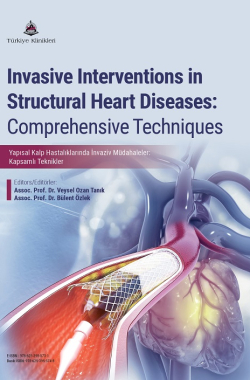NOVEL PERCUTANEOUS TRICUSPID REPAIR TECHNIQUES
Mustafa Ferhat Keten
Koşuyolu Yüksek İhtisas Training and Research Hospital, Department of Cardiology, İstanbul, Türkiye
Keten MF. Novel Percutaneous Tricuspid Repair Techniques. In: Tanık VO, Özlek B, editors. Invasive Interventions in Structural Heart Diseases: Comprehensive Techniques. 1st ed. Ankara: Türkiye Klinikleri; 2025. p.353-359.
ABSTRACT
Tricuspid regurgitation (TR) is an important cause of morbidity and mortality. It is observed more frequently in older ages. 90% of TR cases are functional tricuspid regurgitation. In patients undergoing surgery for left heart valve diseases, the tricuspid valve is also addressed during the procedure. However, the mortality rate of surgery for isolated tricuspid regurgitation is quite high. Recently, percutaneous treatment options have emerged for patients with high surgical risk. One of the most important of these is the percutaneous edge-to-edge repair method, which has stood out for its safety and efficacy following its application to the mitral valve. This method is available in Triklip and Pascal devices. Randomized controlled trials with both devices have demonstrated an improvement in functional capacity and an effective reduction in tricuspid regurgitation. Another repair method is the annuloplasty technique. With the Cardioband system, the annulus is significantly reduced, leading to a decrease in regurgitation. It is believed that more successful outcomes will be achieved with the increased application of these repair methods and the selection of appropriate patient groups.
Keywords: Tricuspid regurtation; Tricuspid repair techniques; Percutaneous edge-to-ege repair; annuloplasty; Percutaneous treatment
Kaynak Göster
Referanslar
- Russo G, Taramasso M, Pedicino D, Gennari M, Gavazzoni M, Pozzoli A, et al. Challenges and future perspectives of transcatheter tricuspid valve interventions: adopt old strategies or adapt to new opportunities? Eur J Heart Fail. 2022;24(3):442-454. [Crossref] [PubMed]
- Zack CJ, Fender EA, Chandrashekar P, Reddy YNV, Bennett CE, Stulak JM, et al. National Trends and Outcomes in Isolated Tricuspid Valve Surgery. J Am Coll Cardiol. 2017;70(24):2953-2960. [Crossref] [PubMed]
- Asmarats L, Puri R, Latib A, Navia JL, Rodés-Cabau J. Transcatheter Tricuspid Valve Interventions: Landscape, Challenges, and Future Directions. J Am Coll Cardiol. 2018 Jun 26;71(25):2935-2956. [Crossref] [PubMed]
- Rodés-Cabau J, Taramasso M, O'Gara PT. Diagnosis and treatment of tricuspid valve disease: current and future perspectives. Lancet. 2016;388:2431-42. [Crossref] [PubMed]
- Nicola Buzzatti, Jean-Michel Juliard, Fabien Praz et al. [Link]
- Topilsky Y, Maltais S, Medina Inojosa J, Oguz D, Michelena H, Maalouf J, et al. Burden of Tricuspid Regurgitation in Patients Diagnosed in the Community Setting. JACC Cardiovasc Imaging. 2019 Mar;12(3):433-442. [Crossref] [PubMed]
- Wang TKM, Akyuz K, Mentias A, Kirincich J, Duran Crane A, et al. Contemporary Etiologies, Outcomes, and Novel Risk Score for Isolated Tricuspid Regurgitation. JACC Cardiovasc Imaging. 2022;15(5):731-744. Epub 2021 Dec 15. [Crossref] [PubMed]
- Vahanian A, Beyersdorf F, Praz F, Milojevic M, Baldus S, Bauersachs J, et al. ESC/EACTS Scientific Document Group. 2021 ESC/EACTS Guidelines for the management of valvular heart disease. Eur J Cardiothorac Surg. 2021;60(4):727-800. [Crossref] [PubMed]
- Feldman T, Kar S, Elmariah S, Smart SC, Trento A, Siegel RJ, et al. EVEREST II Investigators. Randomized Comparison of Percutaneous Repair and Surgery for Mitral Regurgitation: 5-Year Results of EVEREST II. J Am Coll Cardiol. 2015;66(25):2844-2854. [Crossref] [PubMed]
- Hammerstingl C, Schueler R, Malasa M, Werner N, Nickenig G. Transcatheter treatment of severe tricuspid regurgitation with the MitraClip system. Eur Heart J. 2016 Mar 7;37(10):849-53. [Crossref] [PubMed]
- Lurz P, Stephan von Bardeleben R, Weber M, Sitges M, Sorajja P, Hausleiter J, et al. Transcatheter Edge-to-Edge Repair for Treatment of Tricuspid Regurgitation. J Am Coll Cardiol. 2021;77(3):229-239. [Crossref] [PubMed]
- Nickenig G, Lurz P, Sorajja P, von Bardeleben RS, Sitges M, Tang GHL, et al. Percutaneous Edge-to-Edge Repair for Tricuspid Regurgitation: 3-Year Outcomes From the TRILUMINATE Study. JACC Cardiovasc Interv. 2024 Sep 23;17(18):2113-2122. [Crossref] [PubMed]
- Sorajja P, Whisenant B, Hamid N, Naik H, Makkar R, Tadros P, et al. Transcatheter Repair for Patients with Tricuspid Regurgitation. N Engl J Med. 2023;388(20):1833-1842. [Crossref] [PubMed]
- Donal E, Leurent G, Ganivet A, Lurz P, Coisne A, De Groote P, et al. Multicentric randomized evaluation of a tricuspid valve percutaneous repair system (clip for the tricuspid valve) in the treatment of severe secondary tricuspid regurgitation Tri.Fr Design paper. Eur Heart J Cardiovasc Imaging. 2022 Nov 17;23(12):1617-1627. [Crossref] [PubMed]
- Taramasso M, Alessandrini H, Latib A, Asami M, Attinger-Toller A, Biasco L, et al. Outcomes After Current Transcatheter Tricuspid Valve Intervention: Mid-Term Results From the International TriValve Registry. JACC Cardiovasc Interv. 2019;12(2):155-165. [Crossref] [PubMed]
- Kodali S, Hahn RT, Eleid MF, Kipperman R, Smith R, Lim DS, et al. CLASP TR EFS Investigators. Feasibility Study of the Transcatheter Valve Repair System for Severe Tricuspid Regurgitation. J Am Coll Cardiol. 2021;77(4):345-356. [Crossref] [PubMed]
- Planer D, Beeri R, Danenberg HD. First-in-Human Transcatheter Tricuspid Valve Repair: 30-Day Follow-Up Experience With the Mistral Device. JACC Cardiovasc Interv. 2020;13(18):2091-2096. [Crossref] [PubMed]
- Nickenig G, Weber M, Schüler R, Hausleiter J, Nabauer M, von Bardeleben RS, et al. Tricuspid valve repair with the Cardioband system: two-year outcomes of the multicentre, prospective TRI-REPAIR study. EuroIntervention. 2021;16(15):e1264-e1271. [Crossref] [PubMed] [PMC]

